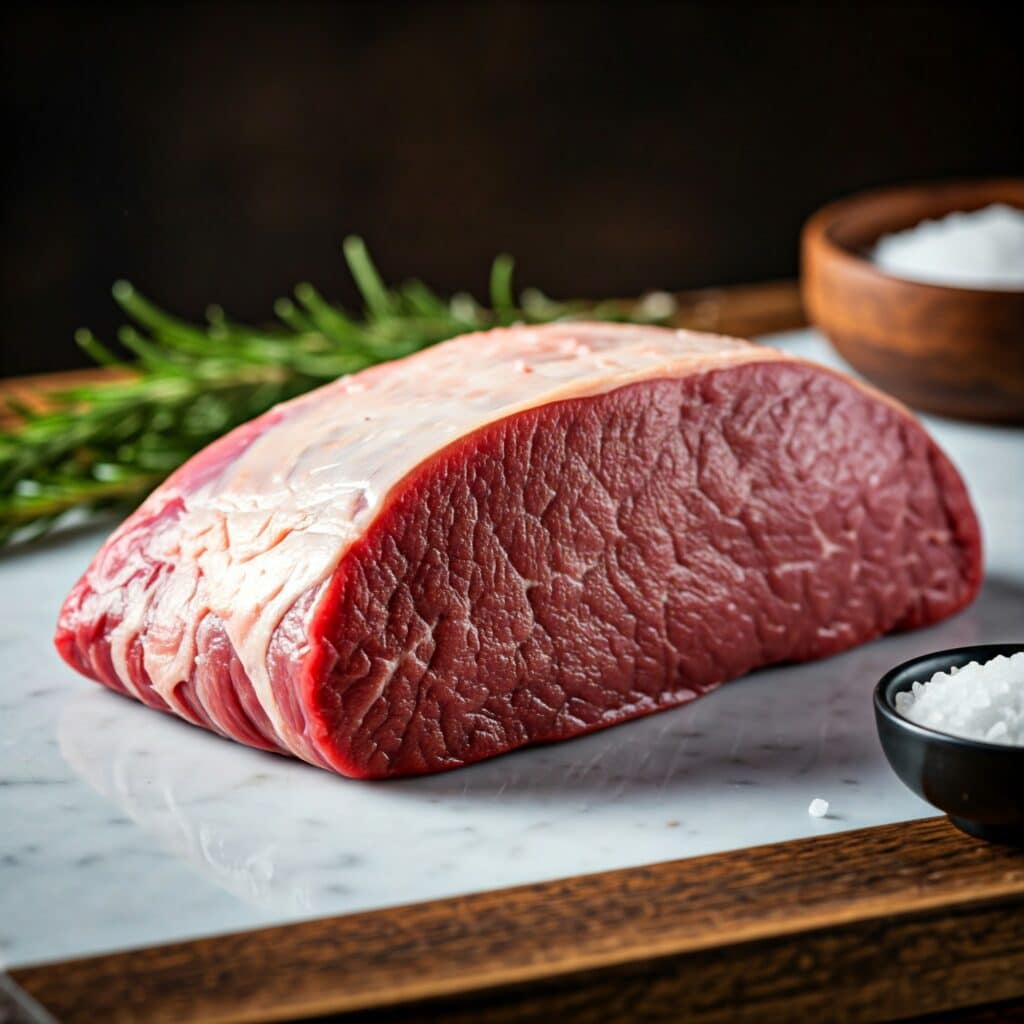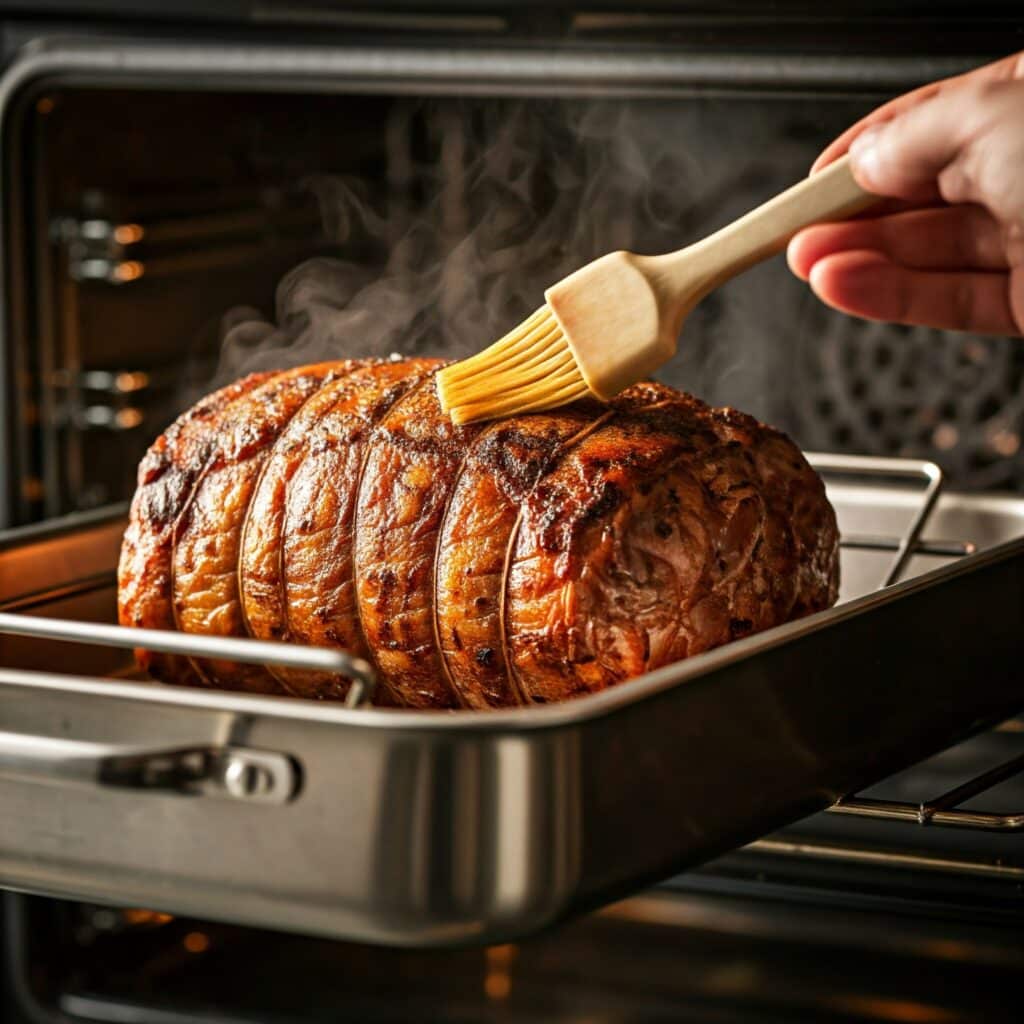Crafting the perfect bottom round roast recipe doesn’t have to be complicated. This article will guide you through everything you need to know about preparing, cooking, and serving this affordable yet flavorful cut of beef. Whether you prefer oven-roasted, slow-cooked, or stovetop-braised recipes, you’ll find tips and tricks to make every bite tender and juicy. Along the way, you’ll learn about the best cooking methods, ideal seasonings, and creative serving ideas. Let’s dive in and master the art of cooking the ultimate bottom round roast.
Understanding Bottom Round Roast
What is Bottom Round Roast?
The bottom round roast is a lean cut from the rear leg of the cow, specifically from the round primal section. It’s known for its affordability and versatility, making it a go-to choice for budget-conscious cooks who don’t want to skimp on flavor. Though it’s naturally tougher due to its lower fat content, the right preparation can transform it into a tender, flavorful meal. Think of it as the hidden gem of beef cuts!
This cut is often compared to similar options like top round roast and chuck roast. However, the bottom round stands out for its slightly firmer texture and ability to hold its shape, making it perfect for slicing thin.
Why is it Popular?
Let’s face it—feeding a family or entertaining guests can get pricey. That’s where the bottom round roast shines. It’s an economical choice that doesn’t compromise on taste. Plus, it’s incredibly versatile: roast it, slow-cook it, or braise it, and you’ve got a dish that pairs beautifully with classic sides like mashed potatoes or roasted veggies.
Nutritionally, it’s a winner too. Packed with protein and low in fat, this roast is ideal for those looking to balance flavor and health. Whether you’re planning a special Sunday dinner or prepping meals for the week, the bottom round roast recipe is a reliable option.
Choosing the Best Bottom Round Roast
What to Look for When Buying
When you’re on the hunt for the perfect cut to create your bottom round roast recipe, it’s essential to choose wisely. Start by examining the roast’s color. Fresh cuts should have a deep, reddish hue with minimal browning or graying. Look for roasts with minimal surface moisture—too much could mean it’s been sitting out for a while.
Another thing to check is the marbling. Although the bottom round is naturally lean, some light marbling (thin streaks of fat) can improve tenderness and flavor during cooking. Don’t forget to ask the butcher about the cut’s source. Grass-fed beef often has a slightly richer flavor, while grain-fed beef tends to be more uniform in texture. If you’re cooking for a crowd, aim for a roast weighing at least 3-4 pounds to ensure enough for everyone.

Grass-Fed vs. Grain-Fed
Choosing between grass-fed and grain-fed beef can feel overwhelming, but it doesn’t have to be. Grass-fed beef offers a more robust flavor profile and is often leaner, making it an excellent match for a bottom round roast recipe. On the other hand, grain-fed beef typically has a milder taste and softer texture, which some find preferable for roasts.
Keep in mind that grass-fed beef may require slightly more attention during cooking to prevent it from drying out. Whichever you choose, both options can create a delectable roast if handled with care.
Preparing for Cooking
Tools You’ll Need
Before diving into the cooking process, it’s crucial to have the right tools on hand. For a bottom round roast recipe, you’ll need a sturdy roasting pan or Dutch oven. These ensure even heat distribution, which is key for tender results. A meat thermometer is another must-have—it takes the guesswork out of cooking and ensures your roast reaches the perfect internal temperature.
Don’t forget a sharp carving knife for slicing the roast thinly. Thin slices are especially important with bottom round, as the cut is leaner and benefits from smaller portions. Lastly, a basting brush and a good pair of tongs can make seasoning and handling the roast much easier.
Marinating or Dry Rubs
The right seasoning can take your bottom round roast recipe from good to unforgettable. If you’re looking to infuse deep flavor, consider marinating the roast overnight. A simple mix of olive oil, garlic, soy sauce, and your favorite herbs works wonders. For a quicker option, a dry rub can provide just as much flavor. Combine salt, pepper, garlic powder, onion powder, and dried rosemary for a classic herb blend.
Marinating helps tenderize the roast, while a dry rub enhances the crust during cooking. Whichever method you choose, be generous with your seasoning to ensure every bite is bursting with flavor.
Resting the Meat Before Cooking
One step many overlook is letting the roast rest before it goes into the oven or slow cooker. Allowing the meat to come to room temperature (about 30-60 minutes) ensures even cooking throughout. Skipping this step could lead to unevenly cooked sections—a common pitfall when preparing a bottom round roast recipe.
Taking these steps before cooking sets the stage for a tender, juicy roast that will impress at the dinner table.
Cooking Methods for Perfect Results
Oven Roasting for a Classic Roast
Oven roasting is one of the most popular methods for creating a perfectly tender bottom round roast recipe. To begin, preheat your oven to 425°F for an initial sear. This high temperature caramelizes the exterior, locking in juices and creating a flavorful crust.
After 15 minutes at this temperature, reduce the oven to 325°F and roast until the internal temperature reaches your desired level of doneness—typically 135°F for medium-rare. Using a meat thermometer ensures accuracy. Don’t skip basting! Basting the roast every 30 minutes keeps it moist and flavorful. Let it rest for 15 minutes before slicing.

For more tips on perfecting your roasts, explore similar recipes like Stuffed Meatloaf with Onion and Mushroom, which also focuses on hearty, comforting meals.
Slow Cooking for Tender Results
For fall-apart tenderness, slow cooking is your best bet. Place your seasoned roast in a crockpot with onions, carrots, and potatoes. Add beef broth or stock until it covers half the roast. Cook on low for 8-10 hours. The extended cooking time allows the meat to tenderize beautifully.
To elevate the flavor, consider adding garlic cloves, fresh thyme, or a splash of Worcestershire sauce. Slow-cooked roasts are ideal for busy days when you want to “set it and forget it.” Plus, they make your home smell heavenly.
Stovetop Searing and Braising
Braising combines searing and slow cooking, making it an excellent method for deep, rich flavors. Start by searing the roast on all sides in a heavy skillet with hot oil. Once browned, transfer the roast to a Dutch oven. Add onions, celery, and beef stock, covering about two-thirds of the roast.
Simmer on low heat for 3-4 hours, occasionally turning the meat for even cooking. The braising liquid can be reduced into a gravy once the roast is cooked. This method produces a succulent dish perfect for family dinners or special occasions.
Best Bottom Round Roast Recipes
Garlic Herb-Crusted Roast
A bottom round roast recipe with a garlic herb crust is a surefire way to impress guests. Begin by combining minced garlic, olive oil, salt, pepper, and fresh herbs like rosemary and thyme. Rub the mixture generously over the roast and let it marinate for at least an hour.
Roast in a preheated oven as described above. This recipe pairs wonderfully with mashed potatoes and steamed green beans. The garlic and herbs infuse the meat with robust flavors, making it a hit at any dinner table.
Bottom Round Roast with Onion Gravy
This comforting recipe combines tender roast beef with a rich, savory onion gravy. After searing the roast, slow cook it with sliced onions, beef broth, and a hint of garlic powder. Once cooked, use the juices and softened onions to create a thick gravy. Serve this dish with buttery mashed potatoes or roasted root vegetables.
For another comforting beef idea, check out French Onion Beef and Noodles for its rich flavors and hearty appeal.
Slow-Cooked Savory Roast
This recipe is perfect for anyone who loves melt-in-your-mouth beef. Prepare a wet rub with mustard, Worcestershire sauce, garlic, and smoked paprika. Coat the roast evenly, then slow cook it with carrots, celery, and baby potatoes. The result? A beautifully tender roast infused with bold, smoky flavors. It’s comfort food at its finest.
For more ideas, consider exploring The Ultimate Meatloaf Seasoning Recipe for inspiration on adding extra flavor to ground or whole cuts of beef.
Tips for Cooking Like a Pro
Using a Meat Thermometer
One of the easiest ways to elevate your bottom round roast recipe is by using a meat thermometer. It takes the guesswork out of cooking, ensuring your roast reaches the perfect temperature. Insert the thermometer into the thickest part of the meat, avoiding bone or fat, for the most accurate reading.
For medium-rare, aim for an internal temperature of 135°F. If you prefer a medium roast, let it cook to about 145°F. Remember, the temperature will rise slightly while the roast rests, so pulling it out a few degrees early is a pro move.
Using a thermometer also helps avoid overcooking—a common mistake that can leave this lean cut tough and dry.
Resting After Cooking
Patience is key when finishing your bottom round roast recipe. Letting the roast rest after cooking allows the juices to redistribute throughout the meat, making every bite juicy and flavorful. Cover the roast loosely with foil and let it rest for about 15-20 minutes before slicing.
Skipping this step might result in a dry roast as the juices escape when you cut into it. Resting isn’t just an extra step—it’s a must for professional-quality results.
Slicing Techniques
Slicing your roast the right way makes a huge difference in texture and flavor. Always slice against the grain, as this shortens the muscle fibers and makes the meat more tender. Use a sharp carving knife to create thin, even slices. This technique works particularly well for serving your roast as the main course or as sandwich meat.
Serving Ideas for Bottom Round Roast
Classic Side Dishes
Pairing the right sides with your bottom round roast recipe can transform it into a memorable meal. Traditional favorites like creamy mashed potatoes, roasted carrots, and sautéed green beans complement the roast’s rich flavors beautifully. A side of freshly baked dinner rolls or crusty bread can round out the meal perfectly.
For a lighter option, consider a simple mixed greens salad with a tangy vinaigrette. This contrast helps balance the hearty flavors of the roast.
Creative Serving Suggestions
Your bottom round roast recipe isn’t just for dinner—it’s versatile enough for leftovers too! Thinly sliced roast makes an excellent filling for roast beef sandwiches. Layer it on crusty bread with a dollop of horseradish sauce or a smear of Dijon mustard for a satisfying lunch.
Another creative option is to use leftover roast in beef tacos. Warm up the slices and pair them with soft tortillas, shredded lettuce, and a drizzle of lime crema for a fresh take on comfort food. These serving ideas ensure that no part of your roast goes to waste.
Storage and Leftover Ideas
How to Store Your Roast
Proper storage ensures your hard work on that bottom round roast recipe doesn’t go to waste. To store leftovers, first allow the roast to cool to room temperature. Wrap it tightly in plastic wrap or aluminum foil to prevent moisture loss, then place it in an airtight container. This method helps preserve the roast’s juicy texture.
For longer storage, freeze the roast. Slice it into individual portions, wrap each piece in plastic wrap, and place them in a freezer-safe bag. When properly stored, your roast can last up to 3-4 days in the fridge or up to 3 months in the freezer.
Reheating Without Drying Out
Reheating a bottom round roast recipe without compromising its texture is easier than you think. The best method is to reheat slices in the oven. Preheat to 300°F, place the slices in a baking dish with a little beef broth, and cover with foil. Heat until warmed through—usually 15-20 minutes.
If you’re in a hurry, you can use the microwave, but be cautious. Add a splash of broth to maintain moisture and heat in short intervals to avoid overcooking. These steps will help your roast stay tender and flavorful, even as leftovers.
Frequently Asked Questions About Bottom Round Roast
How Long Should You Cook a Bottom Round Roast?
Cooking times vary depending on the method and desired doneness. For oven roasting, plan for about 20 minutes per pound at 325°F after the initial high-temperature sear. For a medium-rare bottom round roast recipe, aim for an internal temperature of 135°F, then let it rest.
If you’re slow-cooking, allow 8-10 hours on low heat for the most tender results. Always rely on a meat thermometer for accuracy—it’s your best friend in the kitchen!
Can Bottom Round Roast Be Made Tender?
Absolutely! Despite its reputation as a tougher cut, a bottom round roast recipe can be incredibly tender with the right preparation. Marinating the meat, using a slow-cooking method, or braising it with plenty of liquid are all effective ways to achieve a melt-in-your-mouth texture. Remember, slicing against the grain also helps improve tenderness.
What’s the Best Way to Flavor a Bottom Round Roast?
The beauty of a bottom round roast recipe lies in its versatility. A garlic herb crust is a classic choice that enhances the roast’s natural flavors. Wet rubs and marinades, featuring ingredients like soy sauce, mustard, and Worcestershire sauce, can add depth and complexity. For a unique twist, experiment with spices like smoked paprika or cumin to bring a bold flavor profile to your roast.
Common Mistakes to Avoid
Overcooking the Roast
One of the biggest pitfalls when preparing a bottom round roast recipe is overcooking it. This lean cut doesn’t have much fat to keep it moist, so prolonged cooking can lead to dryness and toughness. To avoid this, always use a meat thermometer to monitor the internal temperature closely. Pull the roast from the heat as soon as it reaches your desired doneness—135°F for medium-rare is a popular choice. Remember, the temperature will continue to rise a few degrees as the roast rests.
If you accidentally overcook your roast, don’t worry! Slicing it thinly and serving it with a flavorful gravy or au jus can help salvage its moisture and taste.
Not Letting the Roast Rest
Skipping the resting period is another common mistake that can ruin an otherwise perfect bottom round roast recipe. Resting allows the juices to redistribute throughout the meat, ensuring every slice is tender and juicy. Without this step, the juices will escape as soon as you cut into the roast, leaving it dry and less flavorful.
Make it a habit to let the roast rest for 15-20 minutes under a loose tent of foil before slicing. Trust us—this small step makes a world of difference!
Ignoring the Grain of the Meat
The way you slice your roast matters just as much as how you cook it. Slicing with the grain instead of against it can result in tougher, chewier meat. When preparing your bottom round roast recipe, take the time to identify the grain (the direction the muscle fibers run) and cut perpendicular to it.
Using a sharp carving knife and slicing thinly also ensures an even, professional presentation. Mastering this technique is the key to serving a roast that’s as tender as it is delicious.
Try This Perfect Bottom Round Roast Recipe Today!
Creating a flavorful, tender bottom round roast recipe is easier than you think! With the right preparation, cooking method, and serving ideas, this affordable cut of beef can become the star of your table. Remember to marinate or season generously, use a meat thermometer for accuracy, and always slice against the grain for maximum tenderness.
Want to expand your cooking skills? Learn how to make savory slow-cooked beef dishes, explore creative sides like roasted potatoes, or perfect homemade sauces to complement your roast.
Whether you’re preparing a weeknight dinner or a holiday feast, this recipe is sure to delight. So gather your tools, pick up a bottom round roast, and get cooking! Your next delicious meal is just a roast away.

